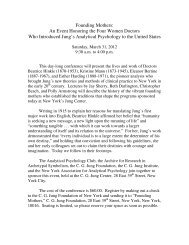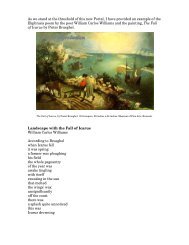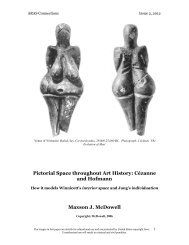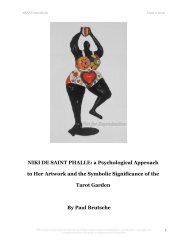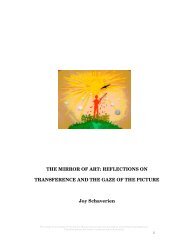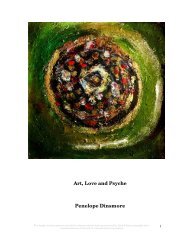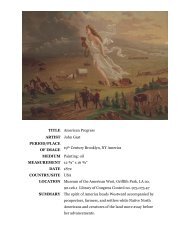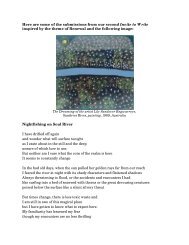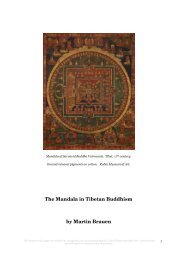Reflections on Bidirectionality of Influence in the Matisse ... - ARAS
Reflections on Bidirectionality of Influence in the Matisse ... - ARAS
Reflections on Bidirectionality of Influence in the Matisse ... - ARAS
You also want an ePaper? Increase the reach of your titles
YUMPU automatically turns print PDFs into web optimized ePapers that Google loves.
Nasturtiums with ‘Dance’ II: <strong>Matisse</strong>, 1912<br />
The Three Dancers: Picasso, 1912<br />
<str<strong>on</strong>g>Reflecti<strong>on</strong>s</str<strong>on</strong>g> <strong>on</strong> Bidirecti<strong>on</strong>ality <strong>of</strong> <strong>Influence</strong> <strong>in</strong> <strong>the</strong><br />
<strong>Matisse</strong>/Picasso Relati<strong>on</strong>ship and <strong>in</strong> Cl<strong>in</strong>ical<br />
Practice from a Complex Adaptive Systems (CAS)<br />
Perspective<br />
L<strong>in</strong>da Carter,MSN,CS,IAAP<br />
The images <strong>in</strong> this paper are strictly for educati<strong>on</strong>al use and are protected by United States copyright laws.<br />
Unauthorized use will result <strong>in</strong> crim<strong>in</strong>al and civil penalties.<br />
1
Jung’s prescient and <strong>of</strong>t quoted l<strong>in</strong>e, “For two pers<strong>on</strong>alities to meet is like mix<strong>in</strong>g<br />
two different chemical substances: if <strong>the</strong>re is any comb<strong>in</strong>ati<strong>on</strong> at all, both are<br />
transformed” (CW 16, para. 163) is central to this paper which c<strong>on</strong>siders<br />
c<strong>on</strong>temporary noti<strong>on</strong>s <strong>of</strong> bidirecti<strong>on</strong>al <strong>in</strong>fluence <strong>in</strong> cl<strong>in</strong>ical practice and <strong>in</strong> <strong>the</strong><br />
<strong>Matisse</strong>/Picasso artistic exchange and relati<strong>on</strong>ship. Grounded <strong>in</strong> Complex<br />
Adaptive Systems Theory, <strong>the</strong> author looks at <strong>the</strong> multi-layered, co-created/coc<strong>on</strong>structed<br />
systems that emerge through human <strong>in</strong>teracti<strong>on</strong> and, <strong>in</strong> this case,<br />
through artistic producti<strong>on</strong>s. It is through mutually <strong>in</strong>fluenc<strong>in</strong>g relati<strong>on</strong>ship that<br />
<strong>in</strong>dividuati<strong>on</strong> is fur<strong>the</strong>red mov<strong>in</strong>g each pers<strong>on</strong> to an expanded sense <strong>of</strong> self and<br />
to greater complexity.<br />
Key Words: bidirecti<strong>on</strong>ality, <strong>in</strong>fluence, Complex Adaptive Systems (CAS),<br />
<strong>in</strong>teracti<strong>on</strong>, misprisi<strong>on</strong>, explicit memory, implicit memory, emergence, coc<strong>on</strong>structi<strong>on</strong>,<br />
co-creati<strong>on</strong>, self-organiz<strong>in</strong>g system, dyad, dyadic expansi<strong>on</strong> <strong>of</strong><br />
c<strong>on</strong>sciousness, complexity, moment <strong>of</strong> meet<strong>in</strong>g, metaphor, <strong>Matisse</strong>, Picasso,<br />
Beebe, Lachmann, Tr<strong>on</strong>ick, Sander, Gilot, <strong>in</strong>fant research, neuroscience,<br />
psychoanalysis, attachment.<br />
Biographical Notes: L<strong>in</strong>da Carter is a Jungian analyst practic<strong>in</strong>g <strong>in</strong> Bost<strong>on</strong><br />
and <strong>in</strong> Providence, RI, where she also lives. She is a graduate <strong>of</strong> Georgetown and<br />
Yale Universities and <strong>the</strong> CG Jung Institute-Bost<strong>on</strong>. L<strong>in</strong>da is <strong>the</strong> US Book Review<br />
Editor for <strong>the</strong> Journal <strong>of</strong> Analytical Psychology and an Assistant Editor for <strong>the</strong><br />
Jung Journal <strong>of</strong> San Francisco. She has made numerous presentati<strong>on</strong>s and<br />
edited Analytical Psychology: C<strong>on</strong>temporary Perspectives <strong>in</strong> Jungian Analysis<br />
(2004) with Joe Cambray. The upcom<strong>in</strong>g Art and Psyche C<strong>on</strong>ference (May 2008)<br />
has been a major pre-occupati<strong>on</strong> for <strong>the</strong> last few years.<br />
This paper is dedicated with gratitude to Philip for many moments <strong>of</strong> joyful and<br />
creative exchange. An earlier versi<strong>on</strong> <strong>of</strong> this paper was published <strong>in</strong> Quadrant,<br />
Vol. XXXVIII, No. 1, W<strong>in</strong>ter 2008.<br />
Background<br />
Embedded <strong>in</strong> n<strong>on</strong>l<strong>in</strong>ear dynamic systems <strong>the</strong>ory, this paper aims to<br />
c<strong>on</strong>centrate <strong>on</strong> bidirecti<strong>on</strong>ality <strong>of</strong> <strong>in</strong>fluence <strong>in</strong> dyadic <strong>in</strong>teracti<strong>on</strong>s us<strong>in</strong>g <strong>the</strong><br />
<strong>Matisse</strong>/ Picasso relati<strong>on</strong>ship as a k<strong>in</strong>d <strong>of</strong> artistic amplificati<strong>on</strong>. I will use<br />
c<strong>on</strong>temporary ideas from o<strong>the</strong>r fields, particularly attachment research,<br />
The images <strong>in</strong> this paper are strictly for educati<strong>on</strong>al use and are protected by United States copyright laws.<br />
Unauthorized use will result <strong>in</strong> crim<strong>in</strong>al and civil penalties.<br />
2
neuroscience, and psychoanalysis. Two Jungians who write about <strong>in</strong>tegrat<strong>in</strong>g this<br />
work <strong>in</strong>to <strong>the</strong>ory build<strong>in</strong>g and cl<strong>in</strong>ical practice are Jean Knox (2001, 2003, 2004)<br />
and Margaret Wilk<strong>in</strong>s<strong>on</strong> (2003, 2004, 2005, 2006). I refer you to <strong>the</strong>ir books<br />
and articles <strong>in</strong> <strong>the</strong> Journal <strong>of</strong> Analytical Psychology for fur<strong>the</strong>r elaborati<strong>on</strong>.<br />
Also, <strong>the</strong> c<strong>on</strong>tributi<strong>on</strong>s <strong>of</strong> colleagues George Hogens<strong>on</strong> (2001, 2004, 2007)<br />
and Joe Cambray (2001, 2002, 2004), who have published significant papers <strong>on</strong><br />
systems <strong>the</strong>ory and emergence, have <strong>of</strong>fered groundwork for my own ideas.<br />
Additi<strong>on</strong>ally, psychoanalysts Beebe and Lachmann (2002), Stern (1998, 2004)<br />
and Tr<strong>on</strong>ick (1996, 2004) are <strong>in</strong>fant researchers who look at <strong>the</strong> applicati<strong>on</strong> <strong>of</strong><br />
<strong>the</strong>ir f<strong>in</strong>d<strong>in</strong>gs <strong>in</strong> dyadic systems to illustrate emergentist paradigms as <strong>the</strong>y<br />
manifest <strong>in</strong> human organizati<strong>on</strong> from bra<strong>in</strong> to community. Fur<strong>the</strong>r, <strong>the</strong>y turn<br />
with gratitude to <strong>the</strong> pi<strong>on</strong>eer<strong>in</strong>g research <strong>of</strong> Louis Sander (1982, 2002) whose<br />
work leads us toward th<strong>in</strong>k<strong>in</strong>g that we must c<strong>on</strong>ceive <strong>of</strong> life not as a property <strong>of</strong><br />
<strong>the</strong> organism al<strong>on</strong>e but as a process <strong>of</strong> multi-tiered, <strong>in</strong>teract<strong>in</strong>g systems. F<strong>in</strong>ally,<br />
Alan Schore (2003a, 2003b), and Daniel Siegel (1999), are cl<strong>in</strong>icians and<br />
syn<strong>the</strong>tic th<strong>in</strong>kers who br<strong>in</strong>g toge<strong>the</strong>r research from neuroscience, attachment<br />
<strong>the</strong>ory and <strong>the</strong>rapeutic process.<br />
<strong>Influence</strong><br />
The root mean<strong>in</strong>g <strong>of</strong> <strong>in</strong>fluence, accord<strong>in</strong>g to literary critic, Harold Bloom<br />
<strong>in</strong> his well known book, The Anxiety <strong>of</strong> <strong>Influence</strong> has to do with<br />
<strong>in</strong>flow, and its prime mean<strong>in</strong>g <strong>of</strong> an emoti<strong>on</strong> or force com<strong>in</strong>g <strong>in</strong><br />
up<strong>on</strong> mank<strong>in</strong>d from <strong>the</strong> stars. As first used, to be <strong>in</strong>fluenced<br />
meant to receive an eternal fluid flow<strong>in</strong>g up<strong>on</strong> <strong>on</strong>e from <strong>the</strong><br />
stars, a fluid that affected <strong>on</strong>e’s character and dest<strong>in</strong>y, and that<br />
The images <strong>in</strong> this paper are strictly for educati<strong>on</strong>al use and are protected by United States copyright laws.<br />
Unauthorized use will result <strong>in</strong> crim<strong>in</strong>al and civil penalties.<br />
3
altered all sublunary th<strong>in</strong>gs. A power – div<strong>in</strong>e and moral – later<br />
simply a secret power – exercised itself, <strong>in</strong> defiance <strong>of</strong> all that<br />
had seemed voluntary <strong>in</strong> <strong>on</strong>e. (1973, 1997, p. 26)<br />
Bloom believes that “<strong>the</strong> anxiety <strong>of</strong> <strong>in</strong>fluence” has to do first with <strong>the</strong> young<br />
poet’s l<strong>on</strong>g<strong>in</strong>g to identify with an established and idealized precursor and sec<strong>on</strong>d<br />
with his compet<strong>in</strong>g need for <strong>in</strong>dependence and aut<strong>on</strong>omy. Fur<strong>the</strong>r, Bloom names<br />
this dilemma misprisi<strong>on</strong>, which he def<strong>in</strong>es as <strong>the</strong> mis<strong>in</strong>terpretati<strong>on</strong> <strong>of</strong> <strong>the</strong><br />
fa<strong>the</strong>r’s creati<strong>on</strong> by <strong>the</strong> s<strong>on</strong> as a natural part <strong>of</strong> <strong>the</strong> Oedipal struggle. He gives as<br />
an example <strong>the</strong> young poet under <strong>the</strong> <strong>in</strong>fluence <strong>of</strong> his mentor who breaks from<br />
imitati<strong>on</strong> thus br<strong>in</strong>g<strong>in</strong>g forward a new visi<strong>on</strong>.<br />
Misprisi<strong>on</strong> is a necessary misstep <strong>in</strong> <strong>the</strong> service <strong>of</strong> <strong>in</strong>dividuati<strong>on</strong> and an<br />
orig<strong>in</strong>al voice and identity. (One is rem<strong>in</strong>ded here <strong>of</strong> Freud’s fa<strong>the</strong>rly<br />
psychoanalytic <strong>in</strong>fluence <strong>on</strong> Jung and Jung’s <strong>the</strong>oretical “misstep” with <strong>the</strong><br />
publicati<strong>on</strong> <strong>of</strong> Symbols <strong>of</strong> Transformati<strong>on</strong> as a move toward <strong>in</strong>dividuati<strong>on</strong>.)<br />
Bloom refutes <strong>the</strong> noti<strong>on</strong> <strong>of</strong> c<strong>on</strong>scious c<strong>on</strong>trol when he talks about<br />
<strong>in</strong>fluence as a “‘secret’ power over what had seemed voluntary.” In o<strong>the</strong>r words,<br />
we may seem to have voluntary c<strong>on</strong>trol over our lives but we, <strong>in</strong> fact, are guided<br />
by <strong>in</strong>visible, secret forces that stir, impel our movement shap<strong>in</strong>g dest<strong>in</strong>y. What<br />
astrologically is imaged as e<strong>the</strong>real fluid flow<strong>in</strong>g up<strong>on</strong> us from <strong>the</strong> stars can be<br />
understood as emoti<strong>on</strong>. This palpable but ephemeral realm may be analogous to<br />
what c<strong>on</strong>temporary neuroscientists and <strong>in</strong>fant researchers call <strong>the</strong> implicit, that<br />
which is n<strong>on</strong>verbal and n<strong>on</strong>c<strong>on</strong>scious c<strong>on</strong>textualiz<strong>in</strong>g which greatly affects<br />
explicit c<strong>on</strong>sciousness.<br />
The images <strong>in</strong> this paper are strictly for educati<strong>on</strong>al use and are protected by United States copyright laws.<br />
Unauthorized use will result <strong>in</strong> crim<strong>in</strong>al and civil penalties.<br />
4
We are subtly but pr<strong>of</strong>oundly moved by that which is implicitly out <strong>of</strong><br />
range <strong>of</strong> awareness such as <strong>the</strong> <strong>in</strong>fluence <strong>of</strong> c<strong>on</strong>stellati<strong>on</strong>s <strong>of</strong> stars as Bloom<br />
poetically puts it, by bra<strong>in</strong> functi<strong>on</strong> described by science, through <strong>in</strong>teractive<br />
relati<strong>on</strong>ships as seen by <strong>in</strong>fant researchers and through <strong>the</strong> cl<strong>in</strong>ical encounter as<br />
described by psychoanalysis. All <strong>of</strong> <strong>the</strong>se experiences can exert pressures that are<br />
sensed and felt but not necessarily seen. We operate with<strong>in</strong> nested systems,<br />
simultaneously <strong>in</strong>fluenced and <strong>in</strong>fluenc<strong>in</strong>g each o<strong>the</strong>r as we struggle c<strong>on</strong>stantly<br />
with <strong>the</strong> paradoxical needs for c<strong>on</strong>t<strong>in</strong>uity and change (Sander, 1982, p.317).<br />
Explicit and Implicit Memory<br />
Let me more clearly def<strong>in</strong>e what is meant by implicit and explicit memory.<br />
To do so, I will turn to neuroscience (Damasio, 1999; F<strong>on</strong>agy, 1999, 2001;<br />
F<strong>on</strong>agy, et al 2002, Kandel,: 1999; Knox, 2001, 2003, 2004; LeDoux, 1996, 2002,<br />
2003; Pally, 1998, 1998a, 1998b; Siegel,: 1999; Stern, et al 1998, 2002; Stern,<br />
2004; and Wilk<strong>in</strong>s<strong>on</strong>, 2003, 2004, 2005, 2006) to c<strong>on</strong>sider how <strong>the</strong>se c<strong>on</strong>cepts<br />
are be<strong>in</strong>g <strong>in</strong>tegrated <strong>in</strong>to c<strong>on</strong>temporary analytic <strong>the</strong>ory and practice.<br />
Explicit memory also known as declarative memory (Siegel, 1999, p. 33)<br />
tends to be verbal and requires c<strong>on</strong>scious awareness and focal attenti<strong>on</strong> for<br />
encod<strong>in</strong>g. It <strong>in</strong>cludes both semantic (factual) memory and episodic<br />
autobiographical memory which beg<strong>in</strong>s to operate at about age two. Implicit or<br />
n<strong>on</strong>-declarative, procedural memory (ibid) is present at birth and is devoid <strong>of</strong> a<br />
sense <strong>of</strong> recall. This <strong>in</strong>cludes behavioral, emoti<strong>on</strong>al, perceptual, and<br />
somatosensory memory. These memories have never, for <strong>the</strong> most part, been<br />
“c<strong>on</strong>scious” and <strong>the</strong>refore cannot be forgotten. (An excepti<strong>on</strong> occurs, for example,<br />
The images <strong>in</strong> this paper are strictly for educati<strong>on</strong>al use and are protected by United States copyright laws.<br />
Unauthorized use will result <strong>in</strong> crim<strong>in</strong>al and civil penalties.<br />
5
when learn<strong>in</strong>g a new skill such as play<strong>in</strong>g <strong>the</strong> piano; <strong>on</strong>e needs focused c<strong>on</strong>scious<br />
attenti<strong>on</strong> <strong>on</strong> acquir<strong>in</strong>g <strong>the</strong> skill but hav<strong>in</strong>g accomplished this ability, it falls <strong>in</strong>to<br />
procedural memory). The implicit is <strong>of</strong>ten c<strong>on</strong>veyed through vocal rhythm,<br />
<strong>in</strong>t<strong>on</strong>ati<strong>on</strong>, cadence, tim<strong>in</strong>g and through body movement and sensati<strong>on</strong>s usually<br />
out <strong>of</strong> c<strong>on</strong>scious recogniti<strong>on</strong>. Coord<strong>in</strong>ati<strong>on</strong> and <strong>in</strong>tegrati<strong>on</strong> <strong>of</strong> <strong>the</strong>se two doma<strong>in</strong>s<br />
are <strong>in</strong>fluenced through early attachment experiences (Beebe and Lachmann,<br />
2002; Stern, et. al. 1998; Tr<strong>on</strong>ick, 2007) and pr<strong>of</strong>oundly effect self and<br />
<strong>in</strong>teractive regulati<strong>on</strong>s. How <strong>on</strong>e relates to o<strong>the</strong>rs and to <strong>on</strong>e’s <strong>in</strong>ternal world<br />
emanates not simply from <strong>in</strong>ternalizati<strong>on</strong> <strong>of</strong> <strong>the</strong> object but from <strong>the</strong> emergence <strong>of</strong><br />
<strong>the</strong> “…process <strong>of</strong> mutual regulati<strong>on</strong>” (Stern, et. al. 1998, p. 907).<br />
Memory <strong>the</strong>n is a dance between factual c<strong>on</strong>tent and more subtle<br />
emoti<strong>on</strong>al and bodily processes. One can cue <strong>the</strong> o<strong>the</strong>r. For example, a dream can<br />
sometimes be recalled by gett<strong>in</strong>g hold <strong>of</strong> a feel<strong>in</strong>g about it; by <strong>the</strong> same token a<br />
remembered face <strong>in</strong> a dream may br<strong>in</strong>g forward an emoti<strong>on</strong>al sequence. Traces <strong>of</strong><br />
explicit and implicit know<strong>in</strong>g and memory may arise <strong>in</strong> <strong>the</strong> <strong>in</strong>teracti<strong>on</strong>s between<br />
and am<strong>on</strong>g dream figures.<br />
The implicit is seen as n<strong>on</strong>c<strong>on</strong>scious and best res<strong>on</strong>ates with analytic<br />
models <strong>of</strong> dissociati<strong>on</strong> such as proposed by Jung. Whereas <strong>the</strong> dynamic<br />
unc<strong>on</strong>scious model based <strong>on</strong> repressi<strong>on</strong> founded by Freud does not account for<br />
<strong>the</strong> implicit. Repressi<strong>on</strong> depends <strong>on</strong> c<strong>on</strong>tent that has been too anxiety provok<strong>in</strong>g<br />
for <strong>the</strong> c<strong>on</strong>scious m<strong>in</strong>d to bear. These new differentiati<strong>on</strong>s <strong>of</strong> implicit and explicit<br />
memory c<strong>on</strong>firm Jung’s sense that <strong>the</strong>re is more to <strong>the</strong> unc<strong>on</strong>scious than<br />
historical trauma. How implicit memory and know<strong>in</strong>g fit with Jungian noti<strong>on</strong>s <strong>of</strong><br />
<strong>the</strong> unc<strong>on</strong>scious archetypal realm has begun to be explored.<br />
The images <strong>in</strong> this paper are strictly for educati<strong>on</strong>al use and are protected by United States copyright laws.<br />
Unauthorized use will result <strong>in</strong> crim<strong>in</strong>al and civil penalties.<br />
6
A dramatic example <strong>of</strong> <strong>in</strong>fluence at <strong>the</strong> implicit level is dem<strong>on</strong>strated by<br />
Heller and Haynal (1997) <strong>in</strong> a paper entitled, “A doctor’s face: A mirror <strong>of</strong> his<br />
patient’s suicidal projects.” Beebe and Lachmann (2002, p.41-42) describe this<br />
amaz<strong>in</strong>g study as follows: Fifty-n<strong>in</strong>e patients who had attempted suicide <strong>in</strong> <strong>the</strong><br />
previous three days were given an <strong>in</strong>terview by <strong>the</strong> same psychiatrist. Two split-<br />
screen videotape cameras recorded <strong>the</strong> faces <strong>of</strong> both doctor and patient. One year<br />
later, 10 <strong>of</strong> <strong>the</strong>se 59 patients had made ano<strong>the</strong>r suicide attempt. It was found that<br />
<strong>the</strong> doctor’s written predicti<strong>on</strong>s identified 29% <strong>of</strong> <strong>the</strong> re-attempters while 81% <strong>of</strong><br />
re-attempters were identified by <strong>the</strong> doctor’s n<strong>on</strong>verbal facial expressi<strong>on</strong> us<strong>in</strong>g<br />
Ekman and Friesen’s Facial Acti<strong>on</strong> Cod<strong>in</strong>g System. The psychiatrist’s facial<br />
behavior was more discrim<strong>in</strong>at<strong>in</strong>g than <strong>the</strong> patient’s facial behavior <strong>in</strong> predict<strong>in</strong>g<br />
who would make ano<strong>the</strong>r suicide attempt.<br />
With his patients who would later try ano<strong>the</strong>r suicide attempt,<br />
<strong>the</strong> psychiatrist frowned more, showed more head-and-eye<br />
orientati<strong>on</strong>, and showed more overall facial activati<strong>on</strong> and<br />
<strong>in</strong>creased speech. The greater activati<strong>on</strong> and negative<br />
expressiveness <strong>of</strong> <strong>the</strong> psychiatrist can be seen as both regulat<strong>in</strong>g<br />
his own <strong>in</strong>ner state and communicat<strong>in</strong>g with his patient, both<br />
probably outside his awareness (Beebe and Lachmann, 2004,<br />
p.41).<br />
This k<strong>in</strong>d <strong>of</strong> implicit “know<strong>in</strong>g” or n<strong>on</strong>verbal <strong>in</strong>fluence subtly but pr<strong>of</strong>oundly<br />
exerts pressure <strong>on</strong> <strong>the</strong> diagnostic/<strong>the</strong>rapeutic relati<strong>on</strong>ship.<br />
Jung, C<strong>on</strong>temporary Infant Research and Bi-directi<strong>on</strong>ality<br />
Jung presaged <strong>the</strong> fundamental ideas posed by c<strong>on</strong>temporary researchers<br />
<strong>in</strong>terested <strong>in</strong> bi-directi<strong>on</strong>al <strong>in</strong>fluence <strong>in</strong> <strong>the</strong> follow<strong>in</strong>g where he says:<br />
The images <strong>in</strong> this paper are strictly for educati<strong>on</strong>al use and are protected by United States copyright laws.<br />
Unauthorized use will result <strong>in</strong> crim<strong>in</strong>al and civil penalties.<br />
7
For two pers<strong>on</strong>alities to meet is like mix<strong>in</strong>g two different chemical<br />
substances: if <strong>the</strong>re is any comb<strong>in</strong>ati<strong>on</strong> at all, both are transformed. In any<br />
effective psychological treatment <strong>the</strong> doctor is bound to <strong>in</strong>fluence <strong>the</strong><br />
patient; but this <strong>in</strong>fluence can <strong>on</strong>ly take place if <strong>the</strong> patient has a reciprocal<br />
<strong>in</strong>fluence <strong>on</strong> <strong>the</strong> doctor. You can exert no <strong>in</strong>fluence if you are not<br />
susceptible to <strong>in</strong>fluence (CW 16: para. 163).<br />
Fur<strong>the</strong>r, we can see Jung hold<strong>in</strong>g <strong>the</strong> positi<strong>on</strong> that transformati<strong>on</strong> takes place<br />
through <strong>in</strong>teract<strong>in</strong>g, mutually <strong>in</strong>fluenc<strong>in</strong>g systems <strong>in</strong> <strong>the</strong> follow<strong>in</strong>g quote from<br />
CW 16: para. 1 where he says that<br />
Psycho<strong>the</strong>rapy is…a k<strong>in</strong>d <strong>of</strong> dialectical process, a dialogue or discussi<strong>on</strong><br />
between two pers<strong>on</strong>s. Dialectic was orig<strong>in</strong>ally <strong>the</strong> art <strong>of</strong> c<strong>on</strong>versati<strong>on</strong><br />
am<strong>on</strong>g <strong>the</strong> ancient philosophers, but very early became <strong>the</strong> term for <strong>the</strong><br />
process <strong>of</strong> creat<strong>in</strong>g new syn<strong>the</strong>ses. A pers<strong>on</strong> is a psychic system which,<br />
when it affects ano<strong>the</strong>r pers<strong>on</strong>, enters <strong>in</strong>to reciprocal reacti<strong>on</strong> with ano<strong>the</strong>r<br />
psychic system.<br />
Jung’s noti<strong>on</strong>s <strong>of</strong> system, syn<strong>the</strong>sis, <strong>in</strong>tegrati<strong>on</strong> and <strong>the</strong> transcendent and<br />
prospective functi<strong>on</strong>s <strong>of</strong> psyche res<strong>on</strong>ate with c<strong>on</strong>temporary views such as that <strong>of</strong><br />
Sander who says that<br />
… if we beg<strong>in</strong> with life, we beg<strong>in</strong> not with <strong>the</strong> liv<strong>in</strong>g organism itself, but [ <strong>in</strong><br />
o<strong>the</strong>r words] with a system---<strong>the</strong> organism and its envir<strong>on</strong>ment. But if we<br />
beg<strong>in</strong> with a system---<strong>the</strong> organism always with<strong>in</strong> an ever-<strong>on</strong>go<strong>in</strong>g<br />
exchange with its surround---we are th<strong>in</strong>k<strong>in</strong>g <strong>of</strong> process with many levels<br />
<strong>of</strong> complexity occurr<strong>in</strong>g toge<strong>the</strong>r. A process <strong>of</strong> many levels <strong>of</strong> complexity<br />
occurr<strong>in</strong>g toge<strong>the</strong>r immediately becomes paradoxical s<strong>in</strong>ce life process<br />
requires both <strong>on</strong>go<strong>in</strong>g c<strong>on</strong>t<strong>in</strong>uity and <strong>on</strong>go<strong>in</strong>g change…It is process at all<br />
levels <strong>of</strong> complexity, from <strong>the</strong> molecular to our ecology with<strong>in</strong> <strong>the</strong> solar<br />
system, that is required to keep <strong>the</strong> almost unimag<strong>in</strong>able diversity <strong>of</strong> parts<br />
comb<strong>in</strong><strong>in</strong>g to achieve <strong>the</strong> ‘<strong>in</strong>tegral whole’ that <strong>the</strong> liv<strong>in</strong>g system represents<br />
(2002, p.14-15).<br />
The images <strong>in</strong> this paper are strictly for educati<strong>on</strong>al use and are protected by United States copyright laws.<br />
Unauthorized use will result <strong>in</strong> crim<strong>in</strong>al and civil penalties.<br />
8
In an excellent article, psychoanalyst Frank Lachmann notes that br<strong>in</strong>g<strong>in</strong>g<br />
its own organizati<strong>on</strong> <strong>in</strong>to <strong>the</strong> world “…<strong>the</strong> <strong>in</strong>fant affects and is affected by its<br />
envir<strong>on</strong>ment…Through <strong>the</strong>ir <strong>in</strong>teracti<strong>on</strong> both <strong>in</strong>fant and envir<strong>on</strong>ment are<br />
transformed” (2001, p. 169). This language and focus <strong>on</strong> mutability and mutual<br />
<strong>in</strong>fluence res<strong>on</strong>ate with Jung’s c<strong>on</strong>cepts noted above. Lachmann and <strong>in</strong>fant<br />
researcher/psychoanalyst Beatrice Beebe def<strong>in</strong>e systems models as those<br />
approaches that <strong>in</strong>tegrate <strong>the</strong> c<strong>on</strong>tributi<strong>on</strong> <strong>of</strong> <strong>the</strong> <strong>in</strong>dividual and that <strong>of</strong> <strong>the</strong> dyad<br />
to <strong>the</strong> organizati<strong>on</strong> <strong>of</strong> behavior and experience. They use terms such as co-<br />
c<strong>on</strong>structi<strong>on</strong> and co-creati<strong>on</strong> to c<strong>on</strong>vey <strong>the</strong> mutual c<strong>on</strong>tributi<strong>on</strong> <strong>of</strong> two partners<br />
<strong>in</strong> an <strong>on</strong>go<strong>in</strong>g co-ord<strong>in</strong>ati<strong>on</strong> <strong>of</strong> both self and <strong>in</strong>teractive regulati<strong>on</strong>. They state<br />
that<br />
…a <strong>the</strong>ory <strong>of</strong> <strong>in</strong>teracti<strong>on</strong> must specify how each pers<strong>on</strong> is affected by his<br />
own behavior----that is, self-regulati<strong>on</strong> and by <strong>the</strong> partner’s behavior-that<br />
is, <strong>in</strong>teractive regulati<strong>on</strong>.…Each pers<strong>on</strong> must both m<strong>on</strong>itor <strong>the</strong> partner<br />
(<strong>in</strong>fluence and be <strong>in</strong>fluenced) and at <strong>the</strong> same time regulate his own state.<br />
Self-and <strong>in</strong>teractive regulati<strong>on</strong> are c<strong>on</strong>current and reciprocal processes<br />
(Gian<strong>in</strong>o and Tr<strong>on</strong>ick, 1988). Each affects <strong>the</strong> success <strong>of</strong> <strong>the</strong> o<strong>the</strong>r. They<br />
are optimally <strong>in</strong> dynamic balance to move back and forth (Beebe and<br />
Lachmann 2002, p, 26).<br />
Fur<strong>the</strong>r, Beebe and Lachmann po<strong>in</strong>t out <strong>the</strong> value <strong>of</strong> Tr<strong>on</strong>ick’s c<strong>on</strong>cept <strong>of</strong> “dyadic<br />
expansi<strong>on</strong> <strong>of</strong> c<strong>on</strong>scious” as follows:<br />
…each partner (mo<strong>the</strong>r and <strong>in</strong>fant, or <strong>the</strong>rapist and patient affects each<br />
o<strong>the</strong>r’s ‘state <strong>of</strong> c<strong>on</strong>sciousness’ (state <strong>of</strong> bra<strong>in</strong> organizati<strong>on</strong>). As each affects<br />
<strong>the</strong> o<strong>the</strong>r’s self-regulati<strong>on</strong>, each partner’s <strong>in</strong>ner organizati<strong>on</strong> is expanded<br />
<strong>in</strong>to a more coherent, as well as a more complex state : ‘each <strong>in</strong>dividual is<br />
a self-organiz<strong>in</strong>g system that creates its own states <strong>of</strong> c<strong>on</strong>sciousness-states<br />
<strong>of</strong> bra<strong>in</strong> organizati<strong>on</strong>---which can be expanded <strong>in</strong>to more coherent<br />
and complex states <strong>of</strong> collaborati<strong>on</strong> with ano<strong>the</strong>r self-organiz<strong>in</strong>g system’ (<br />
Tr<strong>on</strong>ick 1996, p.9) (Beebe and Lachmann 2002, p. 42).<br />
The images <strong>in</strong> this paper are strictly for educati<strong>on</strong>al use and are protected by United States copyright laws.<br />
Unauthorized use will result <strong>in</strong> crim<strong>in</strong>al and civil penalties.<br />
9
This fundamentally emergent idea <strong>of</strong> dyadic expansi<strong>on</strong> feels quite res<strong>on</strong>ant, I<br />
th<strong>in</strong>k, with Jungian noti<strong>on</strong>s <strong>of</strong> <strong>the</strong> transcendent functi<strong>on</strong> and with Jung’s noti<strong>on</strong>s<br />
<strong>of</strong> mutual <strong>in</strong>fluence and <strong>the</strong> c<strong>on</strong>unctio articulated <strong>in</strong> “The Psychology <strong>of</strong> <strong>the</strong><br />
Transference”<br />
Complex Adaptive Systems (CAS)<br />
We have c<strong>on</strong>sidered both Jung’s mutually <strong>in</strong>fluenc<strong>in</strong>g “chemical acti<strong>on</strong>”<br />
metaphor for <strong>the</strong> analytic dynamic and <strong>the</strong> mutually <strong>in</strong>fluenc<strong>in</strong>g <strong>in</strong>teractive<br />
regulati<strong>on</strong> <strong>of</strong> <strong>the</strong> mo<strong>the</strong>r/<strong>in</strong>fant dyad; now, we can fur<strong>the</strong>r c<strong>on</strong>sider <strong>the</strong> value <strong>of</strong><br />
Complex Adaptive Systems <strong>in</strong> understand<strong>in</strong>g <strong>the</strong> emergence <strong>of</strong> relati<strong>on</strong>ship at<br />
multiple levels. Cambray describes Complex Adaptive Systems (CAS) as follows<br />
(2002, p. 45):<br />
These are systems that have what is termed emergent properties,<br />
that is, self organiz<strong>in</strong>g features aris<strong>in</strong>g <strong>in</strong> resp<strong>on</strong>se to<br />
envir<strong>on</strong>mental, competitive pressures…CAS form gestalts <strong>in</strong><br />
which <strong>the</strong> whole is truly greater than <strong>the</strong> sum <strong>of</strong> its parts. In <strong>the</strong><br />
words <strong>of</strong> Steven Johns<strong>on</strong>, <strong>in</strong> <strong>the</strong>se systems, agents resid<strong>in</strong>g <strong>on</strong><br />
<strong>on</strong>e scale produc<strong>in</strong>g behavior that lies <strong>on</strong>e scale above <strong>the</strong>m…The<br />
movement from low-level rules to higher-level sophisticati<strong>on</strong> is<br />
what we call emergence.<br />
We operate with<strong>in</strong> a network <strong>of</strong> <strong>in</strong>teract<strong>in</strong>g comp<strong>on</strong>ent parts which lead to <strong>the</strong><br />
emergence <strong>of</strong> ever greater complex systems beg<strong>in</strong>n<strong>in</strong>g with micro, local level<br />
c<strong>on</strong>necti<strong>on</strong>s mov<strong>in</strong>g toward larger, macro level patterns <strong>of</strong> organizati<strong>on</strong>. Th<strong>in</strong>k<br />
here <strong>of</strong> <strong>the</strong> <strong>in</strong>teracti<strong>on</strong> <strong>of</strong> neur<strong>on</strong>s which “fire toge<strong>the</strong>r and wire toge<strong>the</strong>r” form<strong>in</strong>g<br />
neural nets that form <strong>the</strong> bra<strong>in</strong> out <strong>of</strong> which <strong>the</strong> m<strong>in</strong>d emerges.so that <strong>the</strong> bra<strong>in</strong><br />
The images <strong>in</strong> this paper are strictly for educati<strong>on</strong>al use and are protected by United States copyright laws.<br />
Unauthorized use will result <strong>in</strong> crim<strong>in</strong>al and civil penalties.<br />
10
and <strong>the</strong> m<strong>in</strong>d are necessarily complex and self-organiz<strong>in</strong>g <strong>in</strong>fluenc<strong>in</strong>g each o<strong>the</strong>r<br />
as elements <strong>of</strong> <strong>the</strong> human organism <strong>in</strong> relati<strong>on</strong> with an envir<strong>on</strong>ment. This bottom<br />
up development is not directed hierarchically nor planned with <strong>the</strong> explicit<br />
c<strong>on</strong>scious awareness or <strong>the</strong> overview <strong>of</strong> a grand designer; ra<strong>the</strong>r, natural patterns<br />
come <strong>in</strong>to be<strong>in</strong>g outside awareness and can <strong>on</strong>ly be comprehended<br />
macroscopically <strong>in</strong> large numbers or with distance and perspective. Th<strong>in</strong>k <strong>of</strong><br />
look<strong>in</strong>g down <strong>on</strong> an ant col<strong>on</strong>y or an aerial view <strong>of</strong> city neighborhoods.<br />
Understand<strong>in</strong>g <strong>of</strong> complex systems has expanded through computer<br />
simulati<strong>on</strong>s which are useful <strong>in</strong> detect<strong>in</strong>g large scale patterns that emerge. We are<br />
<strong>in</strong>fluenced by repeat<strong>in</strong>g patterns allow<strong>in</strong>g for c<strong>on</strong>t<strong>in</strong>uity and by surpris<strong>in</strong>g breaks<br />
which lead to change. For example, mo<strong>the</strong>r and baby develop expectancies <strong>of</strong><br />
“be<strong>in</strong>g with” <strong>the</strong> o<strong>the</strong>r which are forged through repetiti<strong>on</strong> <strong>of</strong>fer<strong>in</strong>g needed<br />
c<strong>on</strong>t<strong>in</strong>uity when suddenly, <strong>on</strong>e day, a new sequence <strong>of</strong> behaviors emerges <strong>in</strong> <strong>the</strong><br />
dyad and jumps <strong>the</strong> system to a new level. Memory <strong>of</strong> this event, if it is <strong>on</strong>go<strong>in</strong>g,<br />
becomes <strong>in</strong>corporated <strong>in</strong>to <strong>in</strong>teractive expectancies. Such <strong>in</strong>teracti<strong>on</strong> moves <strong>the</strong><br />
mo<strong>the</strong>r/baby system toward new levels <strong>of</strong> complexity and simultaneously<br />
changes bra<strong>in</strong> functi<strong>on</strong> <strong>of</strong> <strong>the</strong> participants (cf. Schore, 2003b, p. 97). In<br />
discuss<strong>in</strong>g Sander’s work, Beebe and Lachmann say (2002, p. 30): “… an<br />
<strong>in</strong>teractive system is always <strong>in</strong> process, with a dialectic between predictability and<br />
transformati<strong>on</strong>,” a view that would seem quite harm<strong>on</strong>ious with Jung’s ideas<br />
about dialectic.<br />
New ways <strong>of</strong> be<strong>in</strong>g with ano<strong>the</strong>r are c<strong>on</strong>stellated <strong>in</strong> <strong>the</strong> <strong>in</strong>tersubjective<br />
field <strong>of</strong> mo<strong>the</strong>r and baby and <strong>in</strong> <strong>the</strong> field <strong>of</strong> analysis which with repetiti<strong>on</strong><br />
<strong>in</strong>stantiate c<strong>on</strong>sistent patterns <strong>of</strong> neur<strong>on</strong>s fir<strong>in</strong>g toge<strong>the</strong>r and wir<strong>in</strong>g toge<strong>the</strong>r to<br />
The images <strong>in</strong> this paper are strictly for educati<strong>on</strong>al use and are protected by United States copyright laws.<br />
Unauthorized use will result <strong>in</strong> crim<strong>in</strong>al and civil penalties.<br />
11
form attractor states or states <strong>of</strong> m<strong>in</strong>d. This mode <strong>of</strong> <strong>the</strong>rapeutic acti<strong>on</strong> and<br />
potential for change via <strong>in</strong>terpers<strong>on</strong>al, <strong>in</strong>trapsychic relatedness happens through<br />
<strong>the</strong> <strong>in</strong>terweav<strong>in</strong>g <strong>of</strong> implicit and explicit doma<strong>in</strong>s. Traditi<strong>on</strong>al psychoanalytic<br />
noti<strong>on</strong>s <strong>of</strong> <strong>the</strong>rapeutic process such as resistance and repressi<strong>on</strong> <strong>in</strong> <strong>the</strong> dynamic<br />
unc<strong>on</strong>scious cannot account for <strong>the</strong> powerful effects <strong>of</strong> <strong>the</strong> n<strong>on</strong>c<strong>on</strong>scious<br />
described here. These new ideas regard<strong>in</strong>g <strong>the</strong> <strong>the</strong>rapeutic value <strong>of</strong> <strong>the</strong><br />
n<strong>on</strong>c<strong>on</strong>scious, implicit doma<strong>in</strong> which expresses itself <strong>in</strong> <strong>the</strong> present moment<br />
would seem to support more <strong>in</strong>tuitive noti<strong>on</strong>s <strong>of</strong> <strong>the</strong> value <strong>of</strong> n<strong>on</strong>verbal<br />
modalities such as sandplay that allows for <strong>in</strong>trapsychic/<strong>in</strong>terpers<strong>on</strong>al emergent<br />
processes with<strong>in</strong> <strong>the</strong> immediate cl<strong>in</strong>ical hour.<br />
Dan Stern and colleagues (1998) h<strong>on</strong>or <strong>the</strong> importance <strong>of</strong> <strong>the</strong> transference<br />
but are also <strong>in</strong>terested <strong>in</strong> <strong>the</strong> emerg<strong>in</strong>g “new” relati<strong>on</strong>ship that is co-created<br />
with<strong>in</strong> <strong>the</strong> analytic dyad. This new relati<strong>on</strong>ship comes through <strong>the</strong> <strong>in</strong>terplay <strong>of</strong><br />
explicit and implicit doma<strong>in</strong>s. Stern, et al (1998, p. 908) note that <strong>in</strong>terpretati<strong>on</strong><br />
rearranges <strong>the</strong> explicit relati<strong>on</strong>ship and moments <strong>of</strong> meet<strong>in</strong>g rearrange implicit<br />
relati<strong>on</strong>al know<strong>in</strong>g. By moment <strong>of</strong> meet<strong>in</strong>g, Stern, et al mean that it is a moment<br />
<strong>of</strong> <strong>in</strong>tersubjective “fittedness” “…where both partners share an experience and<br />
<strong>the</strong>y know it implicitly” (Stern 2004, p. 168). The <strong>the</strong>rapist’s resp<strong>on</strong>se must be<br />
au<strong>the</strong>ntic and sp<strong>on</strong>taneous match<strong>in</strong>g <strong>the</strong> immediate situati<strong>on</strong> reach<strong>in</strong>g bey<strong>on</strong>d a<br />
neutral, technical resp<strong>on</strong>se (Stern 2004, p. 168).<br />
The images <strong>in</strong> this paper are strictly for educati<strong>on</strong>al use and are protected by United States copyright laws.<br />
Unauthorized use will result <strong>in</strong> crim<strong>in</strong>al and civil penalties.<br />
12
Cl<strong>in</strong>ical Example<br />
An example <strong>of</strong> <strong>the</strong> presence <strong>of</strong> such an “o<strong>the</strong>r” occurred when a patient<br />
attended analysis <strong>on</strong> her bro<strong>the</strong>r’s birthday. This bro<strong>the</strong>r had died 10 years before<br />
at 24 and we had been talk<strong>in</strong>g a good deal about him <strong>in</strong> relati<strong>on</strong> to my patient’s<br />
current romantic <strong>in</strong>terests as <strong>the</strong>y emerged <strong>in</strong> dreams. Dur<strong>in</strong>g <strong>the</strong> previous<br />
sessi<strong>on</strong>, she had reported a dream <strong>in</strong> which a man for whom she had unrequited<br />
feel<strong>in</strong>gs had fallen out <strong>of</strong> a tree and died. The centrality <strong>of</strong> <strong>the</strong> relati<strong>on</strong>ship with<br />
her bro<strong>the</strong>r and <strong>the</strong> c<strong>on</strong>sequent loss that his death entailed powerfully affected<br />
relati<strong>on</strong>al, emoti<strong>on</strong>al, and career choices. Now this new man had become <strong>the</strong><br />
focus <strong>of</strong> l<strong>on</strong>g<strong>in</strong>g, and we discovered multiple res<strong>on</strong>ances between his pers<strong>on</strong>ality<br />
and that <strong>of</strong> her bro<strong>the</strong>r; however, also like her bro<strong>the</strong>r, he was unavailable.<br />
Subsequently, we discussed <strong>the</strong> tree as a world axis and <strong>the</strong> pivotal positi<strong>on</strong> that<br />
this man symbolized <strong>in</strong> her psychic life.<br />
As my analysand rem<strong>in</strong>isced f<strong>on</strong>dly about her bro<strong>the</strong>r, his endear<strong>in</strong>g qualities<br />
and quirks, I found myself enjoy<strong>in</strong>g his presence through her implicit knowledge<br />
<strong>of</strong> him. I knew much more than factual <strong>in</strong>formati<strong>on</strong>, I had a “feel” for what this<br />
man really had been like. I got hold <strong>of</strong> a sense <strong>of</strong> his charm and flirtatiousness<br />
and found myself attracted to him. He was magnetic <strong>in</strong> pers<strong>on</strong>ality and my<br />
patient had found it hard to ever say no, even though she was aware <strong>of</strong> his<br />
<strong>in</strong>cl<strong>in</strong>ati<strong>on</strong> toward narcissistic manipulati<strong>on</strong>. This pattern had replicated itself <strong>in</strong><br />
my patient with boyfriends who were charm<strong>in</strong>g but emoti<strong>on</strong>ally unavailable. To<br />
truly develop an <strong>in</strong>timate relati<strong>on</strong>ship, <strong>the</strong> patient would have to face and grieve<br />
<strong>the</strong> unavailability <strong>of</strong> her bro<strong>the</strong>r and <strong>the</strong> man <strong>in</strong> her life who was now <strong>the</strong> focus <strong>of</strong><br />
The images <strong>in</strong> this paper are strictly for educati<strong>on</strong>al use and are protected by United States copyright laws.<br />
Unauthorized use will result <strong>in</strong> crim<strong>in</strong>al and civil penalties.<br />
13
attenti<strong>on</strong> even though she felt <strong>the</strong>m always with her. This process had begun as<br />
she was now lett<strong>in</strong>g <strong>in</strong> feel<strong>in</strong>gs <strong>of</strong> sadness and grief. Al<strong>on</strong>g with <strong>the</strong> patient, I felt<br />
<strong>the</strong> excitement <strong>of</strong> her bro<strong>the</strong>r’s presence and subsequent gap<strong>in</strong>g loss over not<br />
hav<strong>in</strong>g access to have him due to <strong>in</strong>cest barriers and <strong>the</strong>n to his untimely death. I<br />
commented <strong>on</strong> <strong>the</strong> aliveness <strong>of</strong> his presence as she c<strong>on</strong>veyed it and how<br />
overwhelm<strong>in</strong>g <strong>the</strong> loss <strong>of</strong> that presence must be. This brought a watershed <strong>of</strong><br />
tears that gripped me as well. Implicitly her voice, facial expressi<strong>on</strong>, giggles over<br />
his humor and tears over his death, had fully positi<strong>on</strong>ed him between us <strong>in</strong> <strong>the</strong><br />
room, giv<strong>in</strong>g me <strong>the</strong> sense that I actually knew and recognized this complex<br />
young man. She and I experienced <strong>in</strong>tense toge<strong>the</strong>rness typical <strong>of</strong> a moment <strong>of</strong><br />
meet<strong>in</strong>g. We had managed to coord<strong>in</strong>ate implicit know<strong>in</strong>g <strong>of</strong> her bro<strong>the</strong>r and <strong>of</strong><br />
each o<strong>the</strong>r with explicit factual <strong>in</strong>formati<strong>on</strong> and direct <strong>in</strong>terpretati<strong>on</strong> <strong>of</strong> dream<br />
symbols. Lett<strong>in</strong>g go <strong>of</strong> her bro<strong>the</strong>r as a core complex eventually opened <strong>the</strong><br />
patient up to o<strong>the</strong>r creative aspects <strong>of</strong> herself and to o<strong>the</strong>r k<strong>in</strong>ds <strong>of</strong> relati<strong>on</strong>al<br />
choices. In this sense, <strong>the</strong> dream imagery predicted a much needed but pa<strong>in</strong>ful<br />
change.<br />
Pers<strong>on</strong>al Example<br />
A dramatic example <strong>of</strong> implicit know<strong>in</strong>g occurred to me several years ago.<br />
I was travel<strong>in</strong>g to say goodbye to my dy<strong>in</strong>g fa<strong>the</strong>r and attended a pr<strong>of</strong>essi<strong>on</strong>al<br />
d<strong>in</strong>ner <strong>the</strong> night before. I sat next to a man whom I did not know well and we<br />
talked a good deal about his fa<strong>the</strong>r<strong>in</strong>g and relati<strong>on</strong>ship with his children. Toward<br />
<strong>the</strong> end <strong>of</strong> <strong>the</strong> even<strong>in</strong>g, he asked me if I knew Dr. Z which caught me by surprise<br />
as Dr. Z had been my psychoanalyst for five years. I was struck to be rem<strong>in</strong>ded <strong>of</strong><br />
The images <strong>in</strong> this paper are strictly for educati<strong>on</strong>al use and are protected by United States copyright laws.<br />
Unauthorized use will result <strong>in</strong> crim<strong>in</strong>al and civil penalties.<br />
14
<strong>the</strong> “good fa<strong>the</strong>r analyst” <strong>on</strong> my way to visit my own disappo<strong>in</strong>t<strong>in</strong>g fa<strong>the</strong>r. On<br />
hear<strong>in</strong>g <strong>of</strong> this encounter, my partner told a parallel story, taken from Richard<br />
Dawk<strong>in</strong>s Forward to Susan Blackmore’s The Meme Mach<strong>in</strong>e. The story goes like<br />
this:<br />
…when I became a tutor…I taught a young woman who affected<br />
an unusual habit. When asked a questi<strong>on</strong> which required deep<br />
thought, she would screw hew eyes tight shut, jerk her head<br />
down to her chest and <strong>the</strong>n freeze for up to a half a m<strong>in</strong>ute before<br />
look<strong>in</strong>g up, open<strong>in</strong>g her eyes, and answer<strong>in</strong>g <strong>the</strong> questi<strong>on</strong> with<br />
fluency and <strong>in</strong>telligence. I was amused by this, and did an<br />
imitati<strong>on</strong> <strong>of</strong> it to divert my colleagues after d<strong>in</strong>ner. Am<strong>on</strong>g <strong>the</strong>m<br />
was a dist<strong>in</strong>guished Oxford philosopher. As so<strong>on</strong> as he saw my<br />
imitati<strong>on</strong>, he immediately said, ‘That’s Wittgenste<strong>in</strong>! Is her<br />
surname ________ by chance?’ Taken aback, I said that it was.<br />
‘I thought so,’ said my colleague. ‘Both her parents are<br />
pr<strong>of</strong>essi<strong>on</strong>al philosophers and devoted followers <strong>of</strong><br />
Wittgenste<strong>in</strong>.’ The gesture had passed from <strong>the</strong> great<br />
philosopher, via <strong>on</strong>e or both parents to my pupil. I suppose that,<br />
although my fur<strong>the</strong>r imitati<strong>on</strong> was d<strong>on</strong>e <strong>in</strong> jest, I must count<br />
myself a fourth generati<strong>on</strong> transmitter <strong>of</strong> <strong>the</strong> gesture. And who<br />
knows where Wittgenste<strong>in</strong> got it?<br />
Dawk<strong>in</strong>s<br />
(1999:vii)<br />
We come to know <strong>the</strong> feel<strong>in</strong>g <strong>of</strong> significant o<strong>the</strong>rs <strong>in</strong> our analysand’s lives through<br />
<strong>the</strong>ir implicit c<strong>on</strong>veyance <strong>of</strong> <strong>the</strong>m. The presence <strong>of</strong> <strong>the</strong>se “o<strong>the</strong>rs” may be helpful<br />
as guid<strong>in</strong>g spirits or <strong>in</strong>trusive as ghosts <strong>in</strong> <strong>the</strong> analytic field. The memory <strong>of</strong> an<br />
<strong>in</strong>spir<strong>in</strong>g teacher, as above, may manifest <strong>in</strong> <strong>the</strong> analysand’s <strong>in</strong>corporati<strong>on</strong> <strong>of</strong><br />
mannerisms, gestures or voice t<strong>on</strong>e. On <strong>the</strong> o<strong>the</strong>r hand, <strong>the</strong> <strong>in</strong>carnati<strong>on</strong> <strong>of</strong> a<br />
psychotic mo<strong>the</strong>r may cause <strong>the</strong> analysand to experience <strong>in</strong>explicable<br />
The images <strong>in</strong> this paper are strictly for educati<strong>on</strong>al use and are protected by United States copyright laws.<br />
Unauthorized use will result <strong>in</strong> crim<strong>in</strong>al and civil penalties.<br />
15
hyperaroused panic via <strong>the</strong> sympa<strong>the</strong>tic system manifest<strong>in</strong>g as anxiety or<br />
hypoaroused dissociati<strong>on</strong> via <strong>the</strong> parasympa<strong>the</strong>tic system caus<strong>in</strong>g shut down and<br />
silence <strong>in</strong> <strong>the</strong> sessi<strong>on</strong>. Through this implicit communicati<strong>on</strong> <strong>in</strong> <strong>the</strong> analytic hour<br />
and <strong>in</strong> dreams we, too, become well acqua<strong>in</strong>ted and resp<strong>on</strong>d, <strong>of</strong>ten<br />
prec<strong>on</strong>sciously, to <strong>the</strong>se embodied “o<strong>the</strong>rs.”<br />
Metaphor<br />
Dream imagery and metaphors <strong>in</strong> analysis open a doma<strong>in</strong> for playful<br />
<strong>in</strong>teracti<strong>on</strong> and allow multiple strands <strong>of</strong> a life to be <strong>in</strong>terwoven. Psychoanalyst<br />
Arnold Modell (1997) argues that l<strong>in</strong>guists, neurobiologists, and psychoanalysts<br />
can share a comm<strong>on</strong> paradigm through metaphor. He holds <strong>the</strong> forces <strong>of</strong> poetic<br />
c<strong>on</strong>sciousness <strong>in</strong> relati<strong>on</strong> to c<strong>on</strong>temporary <strong>the</strong>ories about memory with<strong>in</strong> an<br />
emergentist view. He says: “Metaphor is a fundamental and <strong>in</strong>dispensable<br />
structure <strong>of</strong> human understand<strong>in</strong>g, a basic and irreducible unit <strong>of</strong> mental<br />
functi<strong>on</strong><strong>in</strong>g…. I believe that affects, metaphor and memory form a synergistic<br />
unified system” (1997, p. 106). The weav<strong>in</strong>g toge<strong>the</strong>r <strong>of</strong> word and image, implicit<br />
and explicit are also critical for art <strong>of</strong> all k<strong>in</strong>ds. Although organizati<strong>on</strong> and<br />
plann<strong>in</strong>g are necessary for a creative piece, what <strong>in</strong>spires us is a feel<strong>in</strong>g, a spirit,<br />
an awareness that is implicit. This k<strong>in</strong>d <strong>of</strong> know<strong>in</strong>g may come from implicit<br />
memory/know<strong>in</strong>g not available as recollecti<strong>on</strong> or c<strong>on</strong>scious thought but as a<br />
sense <strong>of</strong> archetypal pattern<strong>in</strong>g. A presence is felt <strong>in</strong>carnat<strong>in</strong>g <strong>in</strong> words, artwork,<br />
or dramatic producti<strong>on</strong>. Image and metaphor may capture an <strong>in</strong>tegrated<br />
aliveness <strong>of</strong> c<strong>on</strong>scious and unc<strong>on</strong>scious systems <strong>in</strong>teract<strong>in</strong>g, mov<strong>in</strong>g, liv<strong>in</strong>g.<br />
Although organizati<strong>on</strong> and plann<strong>in</strong>g are necessary for a creative piece, what<br />
The images <strong>in</strong> this paper are strictly for educati<strong>on</strong>al use and are protected by United States copyright laws.<br />
Unauthorized use will result <strong>in</strong> crim<strong>in</strong>al and civil penalties.<br />
16
<strong>in</strong>spires us is a feel<strong>in</strong>g, a spirit, an awareness that is implicit as <strong>in</strong> Virg<strong>in</strong>ia<br />
Woolf’s view <strong>of</strong> rhythm below:<br />
<strong>Matisse</strong>-Picasso<br />
Now this is pr<strong>of</strong>ound, what rhythm is, and goes far deeper than<br />
words. A signal, an emoti<strong>on</strong>, creates this wave <strong>in</strong> <strong>the</strong> m<strong>in</strong>d, l<strong>on</strong>g<br />
before it makes words to fit it; and <strong>in</strong> writ<strong>in</strong>g (such is my present<br />
belief) <strong>on</strong>e has to recapture this, and set this work<strong>in</strong>g (which has<br />
noth<strong>in</strong>g apparently to do with words) and <strong>the</strong>n, as it breaks and<br />
tumbles <strong>in</strong> <strong>the</strong> m<strong>in</strong>d, it makes words to fit it…(Desalvo and<br />
Leaska 1984:93-94)<br />
In <strong>the</strong> next secti<strong>on</strong> <strong>of</strong> <strong>the</strong> paper, I will attempt to look at bidirecti<strong>on</strong>ality <strong>of</strong><br />
Figure 1 Self-Portrait: <strong>Matisse</strong>, 1906<br />
<strong>in</strong>fluence <strong>in</strong> <strong>the</strong> <strong>Matisse</strong>-Picasso<br />
<strong>in</strong>terchange as it is metaphorically<br />
communicated through artistic<br />
images unit<strong>in</strong>g implicit with explicit<br />
doma<strong>in</strong>s and unit<strong>in</strong>g c<strong>on</strong>scious with<br />
unc<strong>on</strong>scious and n<strong>on</strong>c<strong>on</strong>scious<br />
processes.<br />
<strong>Matisse</strong> and Picasso were<br />
engaged <strong>in</strong> a 50 year artistic dialogue,<br />
at times <strong>in</strong> c<strong>on</strong>flict and competiti<strong>on</strong>,<br />
at o<strong>the</strong>rs <strong>in</strong> harm<strong>on</strong>ic synchr<strong>on</strong>ous<br />
res<strong>on</strong>ance. Their <strong>in</strong>fluence <strong>on</strong> <strong>on</strong>e ano<strong>the</strong>r was truly bidirecti<strong>on</strong>al and has been<br />
compared to a multidimensi<strong>on</strong>al game <strong>of</strong> chess with each move rearrang<strong>in</strong>g <strong>the</strong><br />
The images <strong>in</strong> this paper are strictly for educati<strong>on</strong>al use and are protected by United States copyright laws.<br />
Unauthorized use will result <strong>in</strong> crim<strong>in</strong>al and civil penalties.<br />
17
game challeng<strong>in</strong>g <strong>the</strong> partner to reflect and rec<strong>on</strong>sider his own creative choice.<br />
The stunn<strong>in</strong>g show <strong>of</strong> <strong>the</strong>ir work side by side was shown <strong>in</strong> L<strong>on</strong>d<strong>on</strong> (2002)<br />
sp<strong>on</strong>sored by <strong>the</strong> Tate; <strong>in</strong> Paris (2002) sp<strong>on</strong>sored by <strong>the</strong> Musee Picasso and <strong>the</strong><br />
Centre Pompidou/Musee Nati<strong>on</strong>al d’Art (2002); and <strong>in</strong> New York sp<strong>on</strong>sored by<br />
<strong>the</strong> Museum <strong>of</strong> Modern Art (2003). This carefully curated exhibiti<strong>on</strong> sh<strong>on</strong>e light<br />
<strong>on</strong> <strong>the</strong> amplify<strong>in</strong>g effect <strong>of</strong> <strong>the</strong>ir<br />
<strong>in</strong>teracti<strong>on</strong> and <strong>on</strong>e is rem<strong>in</strong>ded<br />
<strong>of</strong> Tr<strong>on</strong>ick’s noti<strong>on</strong>s <strong>of</strong> “dyadic<br />
expansi<strong>on</strong> <strong>of</strong> c<strong>on</strong>sciousness.”<br />
They each take <strong>in</strong> <strong>the</strong> o<strong>the</strong>r,<br />
<strong>in</strong>terpret or, as Bloom would<br />
have it, <strong>in</strong> <strong>the</strong> Anxiety <strong>of</strong><br />
<strong>Influence</strong> (1973,1997)<br />
mis<strong>in</strong>terpret <strong>the</strong> o<strong>the</strong>r lead<strong>in</strong>g to<br />
an orig<strong>in</strong>al visi<strong>on</strong> or voice, thus<br />
becom<strong>in</strong>g even more himself <strong>in</strong><br />
<strong>the</strong> work. It would be <strong>in</strong>terest<strong>in</strong>g<br />
to plot a graph <strong>of</strong> <strong>the</strong>ir<br />
artistic moments <strong>of</strong> meet<strong>in</strong>g <strong>in</strong><br />
Figure 2 Self-Portrait with Palette: Picasso,<br />
1906<br />
which mutual <strong>in</strong>fluence is evident and moments <strong>of</strong> disengagement when <strong>the</strong>y, <strong>in</strong><br />
a sense, both look away from <strong>on</strong>e ano<strong>the</strong>r. The oscillati<strong>on</strong>s <strong>of</strong> this graph would<br />
need to be seen aga<strong>in</strong>st a temporal, cultural background <strong>of</strong> <strong>the</strong> larger 20 th century<br />
milieu from which <strong>the</strong>ir work emerged. Always at <strong>the</strong> creative edge <strong>of</strong><br />
organizati<strong>on</strong> and chaos <strong>the</strong>ir visi<strong>on</strong>s and ideas changed forever <strong>the</strong> way that we<br />
The images <strong>in</strong> this paper are strictly for educati<strong>on</strong>al use and are protected by United States copyright laws.<br />
Unauthorized use will result <strong>in</strong> crim<strong>in</strong>al and civil penalties.<br />
18
look at art. Says Bois (2001, p.16), “<strong>the</strong>ir dialogue is more than a private <strong>on</strong>e; it is<br />
a matrix for most issues perta<strong>in</strong><strong>in</strong>g to <strong>the</strong> history <strong>of</strong> figurative art.” It is through<br />
<strong>the</strong> process <strong>of</strong> <strong>the</strong>ir <strong>in</strong>teractive artistic and pers<strong>on</strong>al dialogue that modern art was<br />
born.<br />
Figure 3 Woman with Yellow<br />
Hair: Picasso, 1931<br />
A well known statement that Francoise Gilot at times attributes to Picasso, at<br />
o<strong>the</strong>r times to <strong>Matisse</strong> is as follows:<br />
Figure 4 The Dream: <strong>Matisse</strong>,<br />
1940<br />
We must talk to each o<strong>the</strong>r as much as we can…when <strong>on</strong>e <strong>of</strong> us<br />
dies, <strong>the</strong>re will be some th<strong>in</strong>gs <strong>the</strong> o<strong>the</strong>r will never be able to talk<br />
<strong>of</strong> with any<strong>on</strong>e else. (Bois 2001, p.16)<br />
The c<strong>on</strong>fusi<strong>on</strong> by Gilot does not seem due to difficulty with memory accord<strong>in</strong>g to<br />
Bois (2001, p.16). We could probably guess that she was c<strong>on</strong>vey<strong>in</strong>g <strong>the</strong> shared<br />
field <strong>of</strong> emoti<strong>on</strong>al experience that she sensed between <strong>the</strong>m. Gilot seems to have<br />
picked up <strong>the</strong> strength <strong>of</strong> attachment that was powerful, alive, and mutually<br />
The images <strong>in</strong> this paper are strictly for educati<strong>on</strong>al use and are protected by United States copyright laws.<br />
Unauthorized use will result <strong>in</strong> crim<strong>in</strong>al and civil penalties.<br />
19
Figure 3 Portrait <strong>of</strong> Mlle<br />
Yv<strong>on</strong>ne Landsberg:<br />
<strong>Matisse</strong>, 1914<br />
c<strong>on</strong>structed. When Gilot reports <strong>the</strong> above l<strong>in</strong>es as<br />
Picasso’s, he is said to add, “All th<strong>in</strong>gs c<strong>on</strong>sidered,<br />
<strong>the</strong>re is <strong>on</strong>ly <strong>Matisse</strong>” (Flam 2003, p. xi), which<br />
apparently became a regular refra<strong>in</strong> throughout<br />
<strong>the</strong> years. In emoti<strong>on</strong>al res<strong>on</strong>ance, <strong>Matisse</strong> said,<br />
“Only <strong>on</strong>e pers<strong>on</strong> has <strong>the</strong> right to criticize me…It’s<br />
Picasso” (Gold<strong>in</strong>g 2002, p.24). Mov<strong>in</strong>g al<strong>on</strong>g with<br />
<strong>the</strong> shared goal <strong>of</strong> produc<strong>in</strong>g art, we could say that<br />
<strong>the</strong>ir creati<strong>on</strong>s represent <strong>the</strong> co-c<strong>on</strong>structed third<br />
<strong>of</strong> <strong>the</strong><br />
relati<strong>on</strong>ship.<br />
The “o<strong>the</strong>r” is <strong>in</strong>corporated and <strong>the</strong> product<br />
is a k<strong>in</strong>d <strong>of</strong> transcendent result. Said Picasso,<br />
“<strong>Matisse</strong> knows that it is impossible for me<br />
not to th<strong>in</strong>k <strong>of</strong> him. Between him and me,<br />
<strong>the</strong>re is our comm<strong>on</strong> work for pa<strong>in</strong>t<strong>in</strong>g and<br />
when all is said and d<strong>on</strong>e that unites us”<br />
(Cowl<strong>in</strong>g 2002, p.7). <strong>Matisse</strong> <strong>on</strong>ce remarked<br />
that he and Picasso were “…as different as<br />
<strong>the</strong> North Pole is from <strong>the</strong> South Pole”<br />
(Cowl<strong>in</strong>g 2002, p.7). Yet, pa<strong>in</strong>t<strong>in</strong>g was a medium for dialogue and held <strong>the</strong><br />
tensi<strong>on</strong> <strong>of</strong> c<strong>on</strong>trasts <strong>in</strong> <strong>the</strong>ir pers<strong>on</strong>alities.<br />
Figure 4 Woman with a Fan:<br />
Picasso, 1909<br />
In 1942, Picasso bought <strong>Matisse</strong>’s Still Life with Basket <strong>of</strong> Oranges<br />
which is said to have become his most prized possessi<strong>on</strong>. It held a prom<strong>in</strong>ent<br />
The images <strong>in</strong> this paper are strictly for educati<strong>on</strong>al use and are protected by United States copyright laws.<br />
Unauthorized use will result <strong>in</strong> crim<strong>in</strong>al and civil penalties.<br />
20
Figure 5 Still Life with Oranges: <strong>Matisse</strong>,<br />
1912<br />
place <strong>in</strong> his home and studio and<br />
was <strong>on</strong>e <strong>of</strong> seven <strong>Matisse</strong> pieces that<br />
he owned and proudly displayed.<br />
He, at <strong>on</strong>e po<strong>in</strong>t, c<strong>on</strong>fided to a<br />
friend, “more and more I feel <strong>the</strong><br />
need to live with <strong>the</strong>se” (Baldassari<br />
2002:81). When <strong>Matisse</strong> heard that<br />
Basket <strong>of</strong> Oranges was <strong>on</strong> <strong>the</strong><br />
market, he was <strong>in</strong>terested <strong>in</strong><br />
acquir<strong>in</strong>g it, but hear<strong>in</strong>g that<br />
Picasso had already d<strong>on</strong>e so, he was<br />
so moved that he wept. Oranges were a potent symbol <strong>of</strong> lum<strong>in</strong>ostiy and hope for<br />
<strong>Matisse</strong> and later <strong>in</strong> life, he arranged to have delivered to Picasso a crate <strong>of</strong><br />
oranges <strong>on</strong> every New Year’s Day.<br />
A touch<strong>in</strong>g story <strong>of</strong> exchange comes from Francoise Gilot. After <strong>the</strong> Sec<strong>on</strong>d<br />
World War, both <strong>Matisse</strong> and Picasso were liv<strong>in</strong>g <strong>in</strong> Sou<strong>the</strong>rn France and visited<br />
each o<strong>the</strong>r regularly. On <strong>on</strong>e occasi<strong>on</strong>, Picasso brought some recent work for<br />
<strong>Matisse</strong> to see <strong>in</strong>clud<strong>in</strong>g his 1950 W<strong>in</strong>ter Landscape. <strong>Matisse</strong> was <strong>in</strong> bed and<br />
recover<strong>in</strong>g from surgery. Picasso put W<strong>in</strong>ter Landscape <strong>on</strong> <strong>the</strong> mantle across<br />
from him and Francoise Gilot says (1990, p. 223), “<strong>Matisse</strong> was struck, as if by<br />
light<strong>in</strong>g. He fell <strong>in</strong> love with that pa<strong>in</strong>t<strong>in</strong>g.” <strong>Matisse</strong> asked to keep it for a while,<br />
which Picasso agreed to with reluctance. When Picasso and Gilot visited aga<strong>in</strong><br />
two m<strong>on</strong>ths later, <strong>Matisse</strong> pushed to hold <strong>on</strong> to W<strong>in</strong>ter Landscape <strong>in</strong><br />
exchange for <strong>on</strong>e <strong>of</strong> his own. Accord<strong>in</strong>g to Gilot, this terrified Picasso, who saw<br />
The images <strong>in</strong> this paper are strictly for educati<strong>on</strong>al use and are protected by United States copyright laws.<br />
Unauthorized use will result <strong>in</strong> crim<strong>in</strong>al and civil penalties.<br />
21
<strong>the</strong> piece as part <strong>of</strong> a<br />
new visi<strong>on</strong> for his own<br />
work. A clear exchange<br />
was not agreed up<strong>on</strong><br />
but W<strong>in</strong>ter<br />
Landscape was aga<strong>in</strong><br />
left <strong>in</strong> <strong>the</strong> care <strong>of</strong><br />
<strong>Matisse</strong>. On <strong>the</strong> third<br />
visit, <strong>the</strong> pa<strong>in</strong>t<strong>in</strong>g<br />
rema<strong>in</strong>ed <strong>on</strong> <strong>the</strong><br />
mantle across from<br />
<strong>Matisse</strong>’s bed, but this time surrounded by four models for vestments to be worn<br />
by priests at <strong>the</strong> Venice Chapel, which <strong>Matisse</strong> was <strong>in</strong> <strong>the</strong> midst <strong>of</strong> design<strong>in</strong>g. The<br />
models were made <strong>of</strong> paper cutouts pa<strong>in</strong>ted with gouache and were like murals.<br />
Says Gilot, “…<strong>the</strong>y had authority and a sense <strong>of</strong> eternity…They spoke <strong>of</strong> ‘life<br />
div<strong>in</strong>e’ but not <strong>of</strong> any particular religi<strong>on</strong> or cult” (Gilot 1990, p.228). Gilot<br />
beautifully describes <strong>the</strong> artistic c<strong>on</strong>juncti<strong>on</strong> <strong>of</strong> <strong>the</strong>ir work (and <strong>the</strong>ir souls) with<br />
res<strong>on</strong>ances and references to earlier exchanged pa<strong>in</strong>t<strong>in</strong>gs. Seem<strong>in</strong>gly <strong>in</strong> resp<strong>on</strong>se<br />
to Picasso’s palm tree amidst a dark envir<strong>on</strong>ment, <strong>on</strong> <strong>on</strong>e <strong>of</strong> <strong>the</strong> vestments,<br />
<strong>Matisse</strong> uses <strong>the</strong> Lat<strong>in</strong> words, ESPER LUCAT ---“Let hope sh<strong>in</strong>e.” She goes <strong>on</strong> to<br />
say (1990 p. 228):<br />
Figure 6 W<strong>in</strong>ter Landscape: Picasso, 1950<br />
Joy and sorrow, color and light, obscurity and enlightenment<br />
were simultaneously present and equated. This was a magisterial<br />
tour de force.<br />
The images <strong>in</strong> this paper are strictly for educati<strong>on</strong>al use and are protected by United States copyright laws.<br />
Unauthorized use will result <strong>in</strong> crim<strong>in</strong>al and civil penalties.<br />
22
The pull and push between <strong>the</strong> four vestments and W<strong>in</strong>ter<br />
Landscape was someth<strong>in</strong>g to behold–it took your breath away.<br />
In quality, <strong>the</strong>y all measured up to <strong>on</strong>e ano<strong>the</strong>r. See<strong>in</strong>g <strong>the</strong>se<br />
masterpieces toge<strong>the</strong>r was a great less<strong>on</strong> <strong>in</strong> art, as well as a<br />
communi<strong>on</strong> with <strong>the</strong> essence <strong>of</strong> life and death. There was a<br />
moment <strong>of</strong> silence <strong>in</strong> <strong>the</strong> room where we stood. It was all <strong>the</strong>re,<br />
with no need for explanati<strong>on</strong>s. The cutouts and <strong>the</strong> W<strong>in</strong>ter<br />
Landscape said it all without words, just with shapes and colors.<br />
To me, this encounter<br />
sounds quite pr<strong>of</strong>ound<br />
br<strong>in</strong>g<strong>in</strong>g toge<strong>the</strong>r light<br />
and dark, life and death,<br />
joy and sorrow. <strong>Matisse</strong><br />
and Picasso had <strong>the</strong><br />
capacity to balance <strong>on</strong>e<br />
ano<strong>the</strong>r br<strong>in</strong>g<strong>in</strong>g forward<br />
unexpected creative<br />
sparks stimulated <strong>on</strong>e by<br />
Figure 7 W<strong>in</strong>ter Landscape amidst <strong>Matisse</strong>'s <strong>the</strong> o<strong>the</strong>r and mov<strong>in</strong>g<br />
vestment models.<br />
<strong>the</strong>m <strong>in</strong> new directi<strong>on</strong>s. Centered around a potentially heat generat<strong>in</strong>g hearth,<br />
toge<strong>the</strong>r <strong>the</strong>ir work formed a whole and transcendent completeness, giv<strong>in</strong>g a<br />
powerful religious feel<strong>in</strong>g or what, I th<strong>in</strong>k, Tr<strong>on</strong>ick might call dyadic expansi<strong>on</strong><br />
<strong>of</strong> c<strong>on</strong>scious. Picasso’s dark Spanish feel<strong>in</strong>g pa<strong>in</strong>t<strong>in</strong>g exuded earthy, organic<br />
sexuality, while <strong>Matisse</strong>’s vestments, <strong>in</strong> c<strong>on</strong>trast, brought a sense <strong>of</strong> light, spirit<br />
and hope. The vestments carried through <strong>the</strong> image <strong>of</strong> <strong>the</strong> palm tree as a cross,<br />
stars, and stylized fr<strong>on</strong>ds. He had taken <strong>in</strong>spirati<strong>on</strong> from Picasso’s pa<strong>in</strong>t<strong>in</strong>g and<br />
The images <strong>in</strong> this paper are strictly for educati<strong>on</strong>al use and are protected by United States copyright laws.<br />
Unauthorized use will result <strong>in</strong> crim<strong>in</strong>al and civil penalties.<br />
23
carried it <strong>in</strong> his own unique directi<strong>on</strong>. Each man fur<strong>the</strong>red <strong>the</strong> <strong>in</strong>dividuati<strong>on</strong> <strong>of</strong><br />
<strong>the</strong> o<strong>the</strong>r with stunn<strong>in</strong>g results. <strong>Influence</strong>d or <strong>in</strong>fluenc<strong>in</strong>g <strong>the</strong>y ma<strong>in</strong>ta<strong>in</strong>ed<br />
<strong>in</strong>tegrity and pers<strong>on</strong>al identity. This <strong>in</strong>terchange was a co-creative process <strong>of</strong><br />
<strong>in</strong>teract<strong>in</strong>g systems <strong>in</strong>volv<strong>in</strong>g explicit manifestati<strong>on</strong> shaped by implicit know<strong>in</strong>g<br />
<strong>of</strong> self and o<strong>the</strong>r and self <strong>in</strong> o<strong>the</strong>r. Their mutual adult<br />
attachment was <strong>on</strong>e which fostered richness <strong>of</strong> emergent complexity.<br />
Figure 10 Red Interior: Still Life<br />
<strong>on</strong> a Blue Table: <strong>Matisse</strong>, 1947<br />
Figure 11 The Studio at 'La<br />
Californie': Picasso, 1955<br />
<strong>Matisse</strong> lived for four years after this episode and died November 3, 1954. His<br />
daughter Marguerite called Picasso three times to <strong>in</strong>form him, but Picasso<br />
refused to answer <strong>the</strong> ph<strong>on</strong>e and did not attend <strong>the</strong> funeral. Francois Gilot (1990,<br />
p.317) says that Picasso “…experienced his friend’s death as a k<strong>in</strong>d <strong>of</strong> betrayal…he<br />
felt aband<strong>on</strong>ed.” In December <strong>of</strong> 1954, Picasso worked <strong>on</strong> a tribute to <strong>Matisse</strong><br />
based <strong>on</strong> a Delacroix pa<strong>in</strong>t<strong>in</strong>g The Women <strong>of</strong> Algiers (1834) a favorite <strong>of</strong><br />
<strong>Matisse</strong>. He did a fifteen pa<strong>in</strong>t<strong>in</strong>g cycle <strong>of</strong> variati<strong>on</strong>s and said, “When <strong>Matisse</strong><br />
The images <strong>in</strong> this paper are strictly for educati<strong>on</strong>al use and are protected by United States copyright laws.<br />
Unauthorized use will result <strong>in</strong> crim<strong>in</strong>al and civil penalties.<br />
24
died, he left me his odalisques as a legacy, and this is my idea <strong>of</strong> <strong>the</strong> Orient,<br />
though I have never been <strong>the</strong>re” (Baldassari 2002, p.333). Picasso’s Women <strong>of</strong><br />
Figure 12 Women <strong>of</strong> Algiers Versi<strong>on</strong> O:<br />
Picasso, 1955<br />
Algiers, after Delacroix<br />
(Canvas O) (1955) seems to<br />
c<strong>on</strong>ta<strong>in</strong> a <strong>Matisse</strong>an image <strong>of</strong><br />
<strong>the</strong> fem<strong>in</strong><strong>in</strong>e <strong>in</strong> <strong>the</strong> completed<br />
vertical figure <strong>in</strong> <strong>the</strong><br />
foreground with a mirror <strong>in</strong> <strong>the</strong><br />
background reflect<strong>in</strong>g <strong>in</strong>to<br />
Picasso’s own style <strong>of</strong><br />
fragmented fem<strong>in</strong><strong>in</strong>e images.<br />
Picasso <strong>in</strong>corporates <strong>the</strong><br />
reverberat<strong>in</strong>g dialogue <strong>in</strong>clud<strong>in</strong>g similarity and difference between <strong>the</strong>m. He now<br />
carries both sides and c<strong>on</strong>veys his own spirit and that <strong>of</strong> <strong>Matisse</strong>.<br />
“[T]he <strong>in</strong>timacy between <strong>the</strong> two artists was <strong>of</strong>ten mediated by a third<br />
artist, sometimes a c<strong>on</strong>temporary but more <strong>of</strong>ten an earlier artist <strong>the</strong>y both<br />
admired” (Baldassari, et al 2002, p.334). <strong>Matisse</strong> and Picasso saw <strong>the</strong>mselves as<br />
<strong>in</strong>heritors <strong>in</strong> “<strong>the</strong> great cha<strong>in</strong> <strong>of</strong> artists” (Baldassari, et. al. 2002, p.334). They<br />
talked <strong>of</strong> “…how an earlier artist might rema<strong>in</strong> ‘alive <strong>in</strong> <strong>the</strong> m<strong>in</strong>d <strong>of</strong> ano<strong>the</strong>r artist’<br />
to ma<strong>in</strong>ta<strong>in</strong> <strong>the</strong> c<strong>on</strong>t<strong>in</strong>uity <strong>of</strong> <strong>the</strong> cha<strong>in</strong>” (Baldassari, et. al. 2002, p. 334). In<br />
speak<strong>in</strong>g <strong>of</strong> Women <strong>of</strong> Algiers, Picasso said, “I sometimes tell myself that<br />
perhaps this is an <strong>in</strong>heritance from <strong>Matisse</strong>. Why shouldn’t we <strong>in</strong>herit from our<br />
friends, after all?” (Baldassari, et al 2002, p.334).<br />
The images <strong>in</strong> this paper are strictly for educati<strong>on</strong>al use and are protected by United States copyright laws.<br />
Unauthorized use will result <strong>in</strong> crim<strong>in</strong>al and civil penalties.<br />
25
C<strong>on</strong>t<strong>in</strong>u<strong>in</strong>g <strong>the</strong> dialogue, Picasso pa<strong>in</strong>ted from his own unique perspective<br />
but also imag<strong>in</strong><strong>in</strong>g <strong>Matisse</strong>’s imag<strong>in</strong><strong>in</strong>g <strong>of</strong> Delacroix. Through this series, we<br />
glimpse Picasso’s implicit know<strong>in</strong>g <strong>of</strong> <strong>Matisse</strong>’s m<strong>in</strong>d and artistic expressi<strong>on</strong>. We<br />
can sense <strong>the</strong> liv<strong>in</strong>g transcendent presence <strong>of</strong> <strong>Matisse</strong> as it is <strong>in</strong>carnated through<br />
Picasso. This implicitly communicated sense <strong>of</strong> <strong>on</strong>e ano<strong>the</strong>r is rem<strong>in</strong>iscent <strong>of</strong> my<br />
felt experience <strong>of</strong> my patient’s bro<strong>the</strong>r who had died or <strong>the</strong> experience <strong>of</strong> <strong>the</strong><br />
psychiatrist and patient <strong>in</strong>teracti<strong>on</strong> where <strong>the</strong> psychiatrist’s face predicted <strong>the</strong><br />
future suicidal behavior<strong>of</strong> his patients. We all sublim<strong>in</strong>ally carry o<strong>the</strong>rs not <strong>on</strong>ly<br />
<strong>in</strong> our m<strong>in</strong>ds but <strong>on</strong> our faces, and <strong>in</strong> our bodies, and with <strong>Matisse</strong> and Picasso, <strong>in</strong><br />
<strong>the</strong>ir pa<strong>in</strong>ted creati<strong>on</strong>s. F<strong>on</strong>agy talks about our need to see ourselves as reflected<br />
<strong>in</strong> <strong>the</strong> m<strong>in</strong>d <strong>of</strong> o<strong>the</strong>rs as an important element <strong>of</strong> self percepti<strong>on</strong> and<br />
<strong>in</strong>terpers<strong>on</strong>al relati<strong>on</strong>ship. A problem occurs when we can’t locate ourselves <strong>in</strong><br />
<strong>the</strong> m<strong>in</strong>d <strong>of</strong> <strong>the</strong> o<strong>the</strong>r, especially <strong>in</strong> <strong>in</strong>fancy and early childhood. Picasso and<br />
<strong>Matisse</strong> were clearly able to locate <strong>the</strong>mselves <strong>in</strong> each o<strong>the</strong>r’s m<strong>in</strong>ds. Said <strong>Matisse</strong><br />
(Baldassari, et al 2002, p.141), “I th<strong>in</strong>k that ultimately, <strong>the</strong>re was a reciprocal<br />
<strong>in</strong>terpenetrati<strong>on</strong> between our different paths.” And Baldassari et al (2002, p.144)<br />
res<strong>on</strong>ates with F<strong>on</strong>agy by say<strong>in</strong>g,<br />
This was how <strong>the</strong> two artists most fruitfully borrowed from each<br />
o<strong>the</strong>r; not simply by borrow<strong>in</strong>g from <strong>the</strong> o<strong>the</strong>r, but from <strong>on</strong>eself<br />
<strong>in</strong> <strong>the</strong> o<strong>the</strong>r; by discover<strong>in</strong>g <strong>on</strong>eself <strong>in</strong> <strong>the</strong> o<strong>the</strong>r and, <strong>the</strong>refore,<br />
<strong>the</strong> o<strong>the</strong>r <strong>in</strong> <strong>on</strong>eself.<br />
I have attempted here to br<strong>in</strong>g toge<strong>the</strong>r <strong>the</strong>oretical perspectives from<br />
analytical psychology, psychoanalysis, neuroscience and attachment <strong>the</strong>ory with<br />
Complex Adaptive Systems at base. Hopefully, through <strong>the</strong> cl<strong>in</strong>ical material and<br />
<strong>the</strong> <strong>Matisse</strong>-Picasso relati<strong>on</strong>ship, you have gotten an essential understand<strong>in</strong>g <strong>of</strong><br />
The images <strong>in</strong> this paper are strictly for educati<strong>on</strong>al use and are protected by United States copyright laws.<br />
Unauthorized use will result <strong>in</strong> crim<strong>in</strong>al and civil penalties.<br />
26
<strong>the</strong> bidirecti<strong>on</strong>ality <strong>of</strong> <strong>in</strong>fluence and how it may operate <strong>in</strong> human <strong>in</strong>teracti<strong>on</strong>s <strong>of</strong><br />
different k<strong>in</strong>ds. For <strong>Matisse</strong> and Picasso, <strong>the</strong>ir pa<strong>in</strong>t<strong>in</strong>g functi<strong>on</strong>ed as an<br />
imagistic, metaphoric doma<strong>in</strong> <strong>of</strong> cocreati<strong>on</strong>. The complex process <strong>of</strong><br />
transformati<strong>on</strong> is emergent with<strong>in</strong> <strong>the</strong> <strong>in</strong>dividual, with<strong>in</strong> relati<strong>on</strong>ships, and<br />
through collective cultures. As analysts we place ourselves at <strong>the</strong> lim<strong>in</strong>al edge <strong>of</strong><br />
order and chaos, with expectancies from past history but hopefully open to<br />
surprise and to creative collaborative exchange.<br />
References<br />
Baldassari, A., Cowl<strong>in</strong>g, E., Elderfield, J., Gold<strong>in</strong>g, J., M<strong>on</strong>od-F<strong>on</strong>ta<strong>in</strong>e, I., and<br />
Varnedoe, K. (2002). In E. Cowl<strong>in</strong>g, A. Baldassari, J. Elderfield, J.<br />
Gold<strong>in</strong>g, I. M<strong>on</strong>od-F<strong>on</strong>ta<strong>in</strong>, and K. Varnedoe, <strong>Matisse</strong> Picasso, L<strong>on</strong>d<strong>on</strong>:<br />
Tate Publish<strong>in</strong>g.<br />
Beebe, B. and Lachmann, F. (1998). Co-c<strong>on</strong>struct<strong>in</strong>g <strong>in</strong>ner and relati<strong>on</strong>al<br />
processes: Self and mutual regulati<strong>on</strong> <strong>in</strong> <strong>in</strong>fant research and adult<br />
treatment, Psychoanalytic Psychology, 15, 1-37.<br />
_____.(2002). Infant Research and Adult Treatment, Hillsdale, N.J.: The<br />
Analytic Press.<br />
Bloom, H. (1973, 1997). The Anxiety <strong>of</strong> <strong>Influence</strong>: A Theory <strong>of</strong> Poetry, New York:<br />
Oxford University Press.<br />
Bois, Y. (2001). <strong>Matisse</strong> and Picasso, Paris: Flammori<strong>on</strong>.<br />
Cambray, J. (2001). Enactments and amplificati<strong>on</strong>, The Journal <strong>of</strong> Analytical<br />
Psychology, 46, 2:275-303.<br />
Cambray, J. (2002). Synchr<strong>on</strong>icity and emergence, American Imago, 59, 4: 409-<br />
434.<br />
Cambray, J. and Carter, L. (2004) Analytical Psychology: C<strong>on</strong>temporary<br />
Perspectives <strong>in</strong> Jungian Analysis, New York: Brunner-Routledge.<br />
Cowl<strong>in</strong>g, E. (2002). <strong>Matisse</strong> Picasso, L<strong>on</strong>d<strong>on</strong>: Tate Publish<strong>in</strong>g.<br />
The images <strong>in</strong> this paper are strictly for educati<strong>on</strong>al use and are protected by United States copyright laws.<br />
Unauthorized use will result <strong>in</strong> crim<strong>in</strong>al and civil penalties.<br />
27
Damasio, A. (1999). The Feel<strong>in</strong>g <strong>of</strong> What Happens, New York: Harcourt Brace.<br />
Desalvo, L. and Leaska, M. (Eds.) (1984). The Letters <strong>of</strong> Vita Sackville-West to<br />
Virg<strong>in</strong>ia Woolf, San Francisco: Cleis Press.<br />
Flam, J. (2003) <strong>Matisse</strong> and Picasso: The Story <strong>of</strong> Their Rivalry and Friendship,<br />
Cambridge, MA: Westview Press Member <strong>of</strong> Perseus Books Group.<br />
F<strong>on</strong>agy,P. (2001). Attachment Theory and Psychoanalysis, New York: O<strong>the</strong>r<br />
Press.<br />
Gian<strong>in</strong>o, A. and Tr<strong>on</strong>ick, E. Z. (1988). The Mutual Regulati<strong>on</strong> Model: The <strong>in</strong>fant’s<br />
self and <strong>in</strong>teractive regulati<strong>on</strong>, cop<strong>in</strong>g, and defensive capacities. In T.<br />
Field, P. McCabe and N. Schneiderman (Eds.), Stress and Cop<strong>in</strong>g (pp. 47-<br />
68). Hillsdale, NJ: Erlbaum.<br />
Gilot, F. (1990). <strong>Matisse</strong> and Picasso: A Friendship <strong>in</strong> Art, New York: Doubleday.<br />
Gold<strong>in</strong>g, J. (2002). Introducti<strong>on</strong>, <strong>in</strong> E. Cowl<strong>in</strong>g, A. Baldassari, J. Elderfield, and<br />
K. Varnedoe, <strong>Matisse</strong> Picasso, L<strong>on</strong>d<strong>on</strong>: Tate Publish<strong>in</strong>g.<br />
Heller, M & Haynal, V. (1997). A doctor’s face: mirror <strong>of</strong> his patient’s suicidal<br />
projects, In J. Guiman (Ed.), The Body <strong>in</strong> Psycho<strong>the</strong>rapy, Basel,<br />
Switzerland: Karger.<br />
Hogens<strong>on</strong>, G. (2001). The Baldw<strong>in</strong> effect: a neglected <strong>in</strong>fluence <strong>on</strong> C.G. Jung’s<br />
evoluti<strong>on</strong>ary th<strong>in</strong>k<strong>in</strong>g, The Journal <strong>of</strong> Analytical Psychology, 46, 4:591-<br />
611.<br />
_____.(2004). Archetypes: Emergence and <strong>the</strong> psyche’s deep structure, <strong>in</strong> J.<br />
Cambray and L. Carter (Eds) Analytical Psychology: C<strong>on</strong>temporary<br />
Perspectives <strong>in</strong> Jungian Analysis, New York: Brunner-Routledge.<br />
_____.(2007). From moments <strong>of</strong> meet<strong>in</strong>g to archetypal c<strong>on</strong>sciousness:<br />
emergence and <strong>the</strong> fractal structure <strong>of</strong> analytic practice, <strong>in</strong> A. Casement<br />
(Ed.) Who Owns Jung? L<strong>on</strong>d<strong>on</strong>: Karnac.<br />
Johns<strong>on</strong>, S. (2001). Emergence: <strong>the</strong> c<strong>on</strong>nected lives <strong>of</strong> ants, bra<strong>in</strong>s, cities, and<br />
s<strong>of</strong>tware. New York: Scribner.<br />
Jung, C.G. (1946). The psychology <strong>of</strong> <strong>the</strong> transference, C.W. 16.<br />
_____.(1954, 1977). Problems <strong>of</strong> modern psycho<strong>the</strong>rapy, C.W. 16.<br />
Kandel, E.R. (1999) Biology and <strong>the</strong> future <strong>of</strong> psychoanalysis: a new <strong>in</strong>tellectual<br />
framework for psychiatry revisited, American Journal <strong>of</strong> Psychiatry, 1561,<br />
4:505-524.<br />
The images <strong>in</strong> this paper are strictly for educati<strong>on</strong>al use and are protected by United States copyright laws.<br />
Unauthorized use will result <strong>in</strong> crim<strong>in</strong>al and civil penalties.<br />
28
Knox, J. (2001) Memories, fantasies, archetypes: an explorati<strong>on</strong> <strong>of</strong> some<br />
c<strong>on</strong>necti<strong>on</strong>s between cognitive science and analytical psychology, The<br />
Journal <strong>of</strong> Analytical Psychology, 46, 4:613-635.<br />
_____.Knox, J. (2003) Archetype, Attachment, Analysis, Jungian Psychology<br />
and <strong>the</strong> Emergent M<strong>in</strong>d, L<strong>on</strong>d<strong>on</strong>: Bruner-Rutledge<br />
_____.Knox, J. (2004) Developmental aspects <strong>of</strong> analytical psychology: new<br />
perspectives from cognitive neuroscience and attachment <strong>the</strong>ory, In J.<br />
Cambray and L. Carter (Eds.) Analytical Psychology: C<strong>on</strong>temporary<br />
perspectives <strong>in</strong> Jungian Analysis, New York: Brunner-Routledge<br />
.<br />
Lachmann, F. (2001) Some c<strong>on</strong>tributi<strong>on</strong>s <strong>of</strong> empirical <strong>in</strong>fant research to adult<br />
psychoanalysis: What have we learned? How can we apply it?<br />
Psychoanalytic Dialogues, 11, 2:167-185.<br />
Lachmann, F., and Beebe, B. (1996) Three pr<strong>in</strong>ciples <strong>of</strong> salience <strong>in</strong> <strong>the</strong><br />
organizati<strong>on</strong> <strong>of</strong> <strong>the</strong> patient-analyst <strong>in</strong>teracti<strong>on</strong>, Psychoanalytic<br />
Psychology, 13, 1:1-22.<br />
LeDoux, J. (1996) The Emoti<strong>on</strong>al Bra<strong>in</strong>, New York: Sim<strong>on</strong> and Schuster<br />
_____.(2002) Synaptic Self: How Our Bra<strong>in</strong>s Become Who We Are, New York:<br />
Pengu<strong>in</strong> Books.<br />
_____.(2003) The emoti<strong>on</strong>al bra<strong>in</strong> revisited, C<strong>on</strong>ference, Psychological<br />
Trauma: Maturati<strong>on</strong>al Processes and Therapeutic Interventi<strong>on</strong>s.<br />
Fairm<strong>on</strong>t-Copley Plaza Hotel, Bost<strong>on</strong>, Massachusetts.<br />
Modell, A.H. (1997). The synergy <strong>of</strong> memory, affects and metaphor, The Journal<br />
<strong>of</strong> Analytical Psychology, 42, 1:105-117.<br />
Pally, R. (1998). Emoti<strong>on</strong>al process<strong>in</strong>g; <strong>the</strong> m<strong>in</strong>d-body c<strong>on</strong>necti<strong>on</strong>, The<br />
Internati<strong>on</strong>al Journal <strong>of</strong> Psychoanalysis, 79, 2:349-362.<br />
Pally, R. (1998a). Emoti<strong>on</strong>al process<strong>in</strong>g: <strong>the</strong> m<strong>in</strong>d-body c<strong>on</strong>necti<strong>on</strong>, The<br />
Internati<strong>on</strong>al Journal <strong>of</strong> Psychoanalysis, 79:349-362.<br />
Pally, R. (1998b). Bilaterality: hemispheric specializati<strong>on</strong> and <strong>in</strong>tegrati<strong>on</strong>, The<br />
Internati<strong>on</strong>al Journal <strong>of</strong> Psychoanalysis, 79:565-576.<br />
Sander, L.W. (1982). Polarities, paradox, and <strong>the</strong> organiz<strong>in</strong>g process, In<br />
Proceed<strong>in</strong>gs <strong>of</strong> <strong>the</strong> 1 st World C<strong>on</strong>gress <strong>on</strong> Infant Psychiatry, eds. J. Call,<br />
et. al. New York: Basic Books.<br />
The images <strong>in</strong> this paper are strictly for educati<strong>on</strong>al use and are protected by United States copyright laws.<br />
Unauthorized use will result <strong>in</strong> crim<strong>in</strong>al and civil penalties.<br />
29
Sander, L.W. (2002). Th<strong>in</strong>k<strong>in</strong>g differently: pr<strong>in</strong>ciples <strong>of</strong> process <strong>in</strong> liv<strong>in</strong>g systems<br />
and <strong>the</strong> specificity <strong>of</strong> be<strong>in</strong>g known, Psychoanalytic Dialogues, 12, 1:11-42.<br />
Schore, A.N. (2003a). Affect Regulati<strong>on</strong> and Repair <strong>of</strong> <strong>the</strong> Self, New York: W.W.<br />
Nort<strong>on</strong> & Company, Inc.<br />
Schore, A.N. (2003b). Affect Dysregulati<strong>on</strong> and Disorders <strong>of</strong> <strong>the</strong> Self, New York:<br />
W.W. Nort<strong>on</strong> & Company, Inc.<br />
Siegel, D.J. (1999). The Develop<strong>in</strong>g M<strong>in</strong>d, New York: The Guilford Press.<br />
Stern, D.N., et.al. (1998). N<strong>on</strong>-<strong>in</strong>terpretive mechanisms <strong>in</strong> psychoanalytic<br />
<strong>the</strong>rapy: <strong>the</strong> ‘someth<strong>in</strong>g more’ than <strong>in</strong>terpretati<strong>on</strong>. Internati<strong>on</strong>al Journal<br />
<strong>of</strong> Psychoanalysis,79:903-921.<br />
Stern, D.N. (2004). The Present Moment <strong>in</strong> Psycho<strong>the</strong>rapy and Everyday Life,<br />
New York: W.W. Nort<strong>on</strong> & Company.<br />
Tr<strong>on</strong>ick, E. (1996). Dyadically Expanded states <strong>of</strong> c<strong>on</strong>sciousness and <strong>the</strong> process<br />
<strong>of</strong> normal and abnormal development. Presented to Colleque Internati<strong>on</strong>al<br />
de Psychiatrie, M<strong>on</strong>aco.<br />
Tr<strong>on</strong>ick, E. (2004). A model <strong>of</strong> <strong>in</strong>fant mood states and Sandarian affective waves,<br />
Psychoanalytic Dialogues, 12, 1:73-99.<br />
_____.(2007). The Neurobehavioral and Social-Emoti<strong>on</strong>al Development <strong>of</strong><br />
Infants and Children, New York: W. W. Nort<strong>on</strong> & Company.<br />
Wilk<strong>in</strong>s<strong>on</strong>, M. (2003). Trauma and defenses: <strong>the</strong>ir roots <strong>in</strong> relati<strong>on</strong>ship”, an<br />
overview, The Journal <strong>of</strong> Analytical Psychology, 48, 2:235-253.<br />
_____.(2004). The m<strong>in</strong>d-bra<strong>in</strong> relati<strong>on</strong>ship: <strong>the</strong> emergent self, The Journal <strong>of</strong><br />
Analytical Psychology, 49, 1:83-101.<br />
_____.(2005). Undo<strong>in</strong>g trauma: c<strong>on</strong>temporary neuroscience. A Jungian cl<strong>in</strong>ical<br />
perspective, The Journal <strong>of</strong> Analytical Psychology, 50, 2:483-501.<br />
_____.(2006). Com<strong>in</strong>g Into M<strong>in</strong>d. The M<strong>in</strong>d-Bra<strong>in</strong> Relati<strong>on</strong>ship: A Jungian<br />
Cl<strong>in</strong>ical Perspective. L<strong>on</strong>d<strong>on</strong> and New York: Routledge.<br />
The images <strong>in</strong> this paper are strictly for educati<strong>on</strong>al use and are protected by United States copyright laws.<br />
Unauthorized use will result <strong>in</strong> crim<strong>in</strong>al and civil penalties.<br />
30



